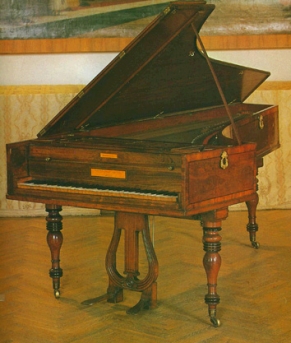Broadwood grands
John Broadwood & Sons, London 1817, Budapest Magyar Nemzeti Múzeum
(former possession of Ludwig van Beethoven)
Ober his life Beethoven owned at least four grand pianos (probably far more). This one he got as a present from London in 1818, after Thomas Broadwood, one of the owners of the firm John Broadwood & Sons and great admirer had visited him in Vienna. After Beethiven's death the instrument went into Franz Liszt's possession who later presented it to the Hungarian nation.
music sample:
(excerpt) Ludwig van Beethoven: Sonate Nr. 27, op. 90
played by Malcolm Binns
Instrument: grand piano Broadwood 1819, Broadwood collection
music sample:
(excerpt) Frederic Chopin, Barcarole f sharp major, op.60
played by Malcolm Binns
Instrument: grand piano Broadwood 1847
“Emma as soon as she entered the room had been struck by the sight of a pianoforté [!] – a very elegant looking instrument – not a grand, but a large-sized square pianoforté; and the substance of the story … was, that this pianoforté had arrived from Broadwood’s the day before … At last Jane began, and though the first bars were feebly given, the powers of the instrument were gradually done full justice to … Emma joined her in her praise; and the pianoforté, with every proper discrimination was pronounced to be altogether of the highest promise … the softness of the upper notes I am sure is exactly what he and all party would particularly prize. I dare say … that he either gave his friend very minute directions, or wrote to Broadwood himself.’” (Jane Austen, Emma)
Jane Austen's novels, as well as numerous passages by other Victorian authors contain many indications about the piano's part in society (here, as often, a square piano).
The piano formed the focal point in the drawing room for a society joining around like in a ritual to listen to music and the central figures. Domestic piano playing was a female preoccupation as a sign of cultivated education received and passed on.
Animation of a Broadwood (English) action:
Film of a Broadwood action:
The situation in concert halls differed considerably: During the 19th century piano virtuosity flourished and (usually male) virtuosos were admonished: Heller, Schobert, Steibelt, Clementi, Dussek, Field, Mendelssohn, Chopin, Moscheles, Thalberg, but above all Franz Liszt created an image of celebrated, admired, idolised "piano magicians" during countless tours in all of Europe and later the Americas. But not only the concert-goers gathered around those virtuosos, the great piano-manufacturers as well tried to support those, at best exclusively, with their instruments to win them for advertising their products. Around mid-19th century many pianists were already contracted by piano firms and those who were not yet, were fiercefully wooed. So Chopin while in London 1848 had three pianos in his quarters to choose from: one each from the London dependencies of Erard and Pleyel, and a Broadwood.
A very special eulogy was the grand sent by Thomas Broadwood in 1817 to Ludwig van Beethoven (later in the possession of Franz Liszt, now in national museum Budapest); the long transport by boat from London and subsequently on land to Vienna did the instrument no good so that the instrument needed a huge amount of repair after arrival. In Vienna the instrument was much admired and discussed and initiated a first discussion about the different features of English pianos. Whether Beethoven composed piano works for "his" Broadwood grand is doubtful though, because its compass would not match his piano works from 1917 on.
Typical elements of English grands were the angular exterior profile with a singularly bent wall and high rectangular fronts and the split right pedal for raising the dampers separately for treble and bass side. This pattern is a peculiarity of English grands; the practical use as a way of expression of this as such very useful mechanism is unclear.
© Greifenberger Institut für Musikinstrumentenkunde | info@greifenberger-institut.de




